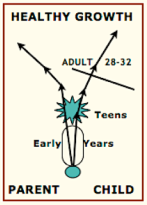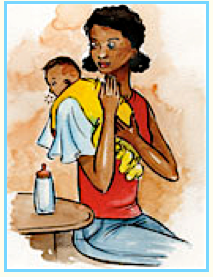I GET ALL MY NEEDS MET
& I don‘t have to do anything!
PREVIOUS: Bs – Healthy Source (Part 1)
REMINDER: See ACRONYM page for abbrev.
1. NORMAL DEVELOPMENT (cont.)
While going through the Developmental Process, children look to their parents to be the source of all PMES provisions:
• Parents are experienced as ‘gods’ = all-powerful, all-knowing, all-providing, & baby has direct access, without having to earn it
• Small children have strong & erratic emotions. When the mother is not emotionally fragile – their adoration, clinging, neediness, tantrums, withdrawals, rages…. will not injure or topple ‘god’ – ie. Love is NOT conditional on the child’s behavior or reactions towards the parent. When her love is unfailing, the universe is safe!
John Bradshaw often stated: Before the age of 7 children ‘deify their parents, & after 7 they parentalize their Deity’. This means that how we experience a Higher Power is a reflection of how well or how badly our parents treated us! But this is not who God is, since He has no weakness. A truism from ACA meetings is that “God is NOT an alcoholic parent”!
• Without their own boundaries, infants need the mother’s affection & attention to not be ambivalent, because babies have to deal with:
External stressors:
Too much input coming at them from many sources, which the y can’t process by themselves. Mother needs to arrange their world to minimize over-stimulation, while also providing the right amount (touch, music, talking…). Her ability to limit internal & external excitement for baby is a substitute for its lack of defenses, until it can mature to form it’s own
y can’t process by themselves. Mother needs to arrange their world to minimize over-stimulation, while also providing the right amount (touch, music, talking…). Her ability to limit internal & external excitement for baby is a substitute for its lack of defenses, until it can mature to form it’s own
Internal stressors:
• Physical needs: hunger, wetness, gas / need for safety & comfort…. for caregiver to protect from discomfort & pain = holding, burping, changing, feeding, attention, affection….
• Emotional reactions: extreme, all B & W, without grays – rage, terror, intense frustration, as well as over-excitement, joy, pleasure…. Need for mother to tame & channel emotional buildups before they explode, by breaking into the child’s ‘trance’ of intensity, whether too high or too low.
Also to limit & protect child from their own behaviors (pounding their head or first, throwing a tantrum, manically running around, screaming with excitement….)
Mother needs to have good Bs, so she can:
• be emotionally available & responsive to baby, AND provide a one-way affection bond, allowing the child the freedom to develop in a protected environment, without having to take care of the adult
• give baby reliable non-verbal communications & appropriate interactions, to establish the child’s ability to trust others
• clearly give the message that having needs & getting them met is normal, acceptable & will not harm her in any way
REMEMBER – It’s not possible to have sound boundaries without the right to having needs
In a HEALTHY family, children learn that:
• parents’ emotions are consistent & separate from those of the child
• parents do not compete with their children for anything: not for attention, affection, information, skills, friends, support, validation….
• kids are allowed a wide range of emotions without punishment
• extremes of emotions do not usually indicate ‘reality’ (danger)
• managing all emotions is taught, directly & by example
• a distinction is clearly made between real trauma & small problems
CHART: Healthy Attachment & Separation
Birth: mother & child are ONE – normal symbiosis
Early years: parents are a stable, consistent source of comfort and knowledge. Children’s emotional life is intense & extreme, fluctuating a great deal.
As they grow, they need the opportunity to move away from under the parental wing for self-expression & then back again, knowing they’ll be welcomed without judgment AND without hurting their parent’s feelings or ego for being a separate entity!
The child can make mistakes, be emotionally dramatic, learn about their capacities & limits, knowing there’s a safe base to return to.
Adolescence: a time for more distinct separation & individuation. Some rebellion is necessary, & separation is achieved by forming outside attachments, including limited sexual interplay
Adulthood: a clear sense of self. Parents are never peers, only other adults whom we value & love but do not n-e-e-d!
Next: ACoAs & Boundaries (#1)


This makes me want to do it all again and get it right for my kids. I know I did it far better than my mother, and I know I got much wrong.
If only we had a chance to go back and get it right (more right).
I love the paragraph about mum needing to help process and minimize the over stimulation coming in. I know that I often got over stimulated and found it scary (and know that I avoid that now as an adult).
I’m gonna have to move to NYC and start back in therapy I think 😉
I will reblog, and hope and wish that many others see your blog and make good use of it.
LikeLike
Reblogged this on musings from outside the asylum and commented:
This is such good info, especially for those of you currently with a young baby. It makes me want to go back and do it again and get it right.
LikeLike
OMG. I am upset, angry, etc. when I read this post. (I’m also super glad to have this info). I’m going to have to go pound on something. A lot of this hits me HARD. It makes me re-live some serious wounds. Actually I never stopped living these wounds. I just see where they developed from reading this. Poor, poor, poor Little Tara. @#$%&**! I am so pissed.
LikeLike
Yes – much compassion for the wounded little One!
LikeLike